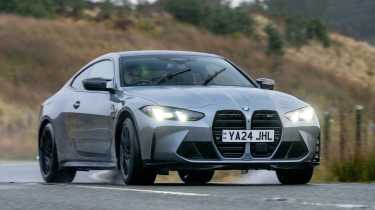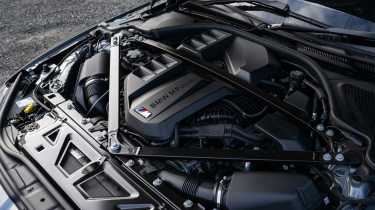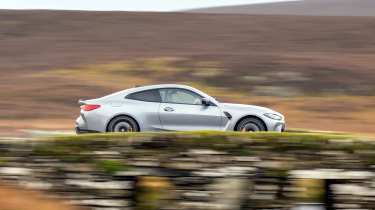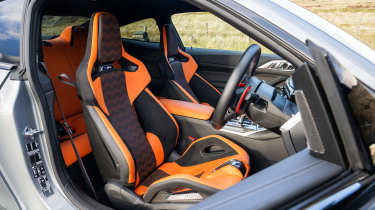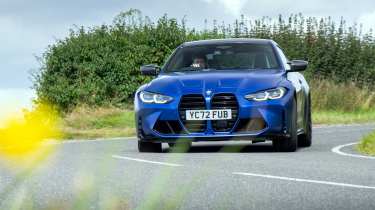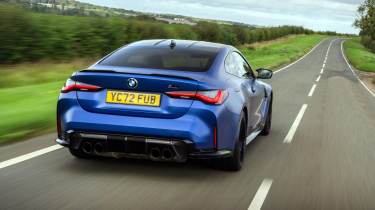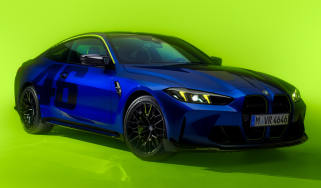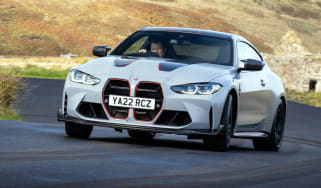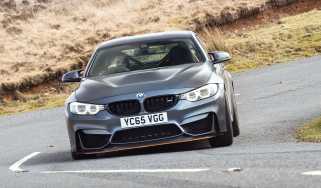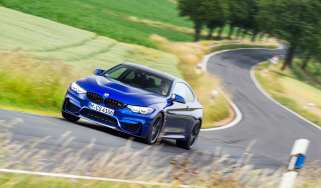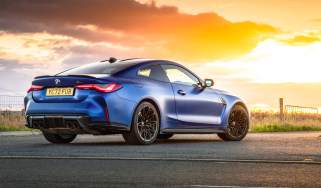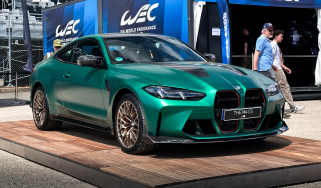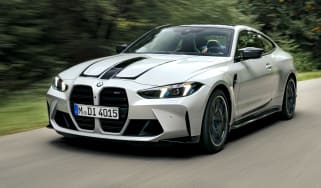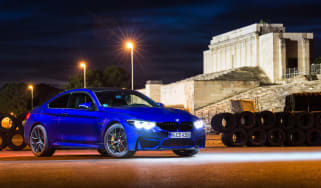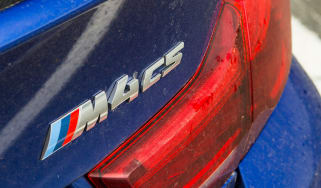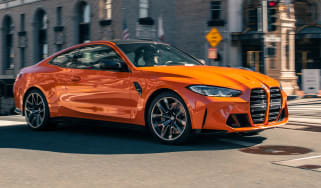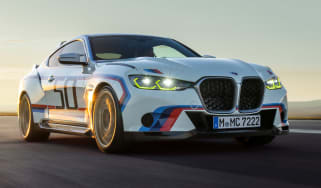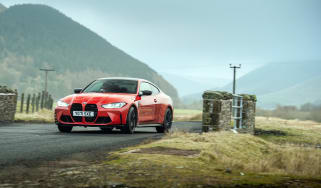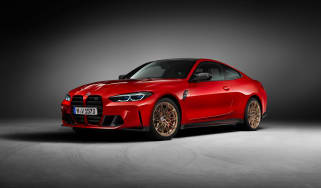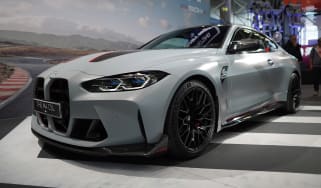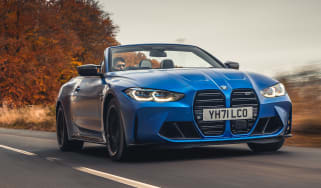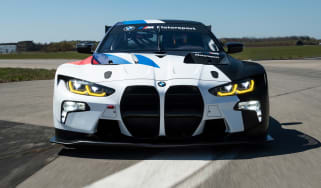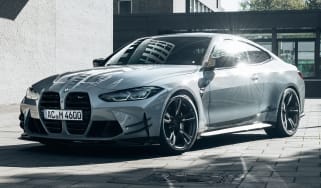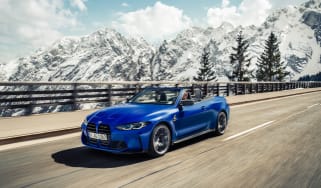BMW M4 2025 review – a brash, bruising and exciting Porsche 911 rival
The updated BMW M4 Competition xDrive packs a 523bhp punch and a broad spread of abilities, but does it thrill like a true M car?
It’s hard not to make negative assumptions about the G82 BMW M4 Competition. Firstly, there’s the way it looks. We may have gotten used to its beaver-teeth front end and bulky proportions since it was first shown in 2020, but time hasn’t made it any more elegant. Then there’s the kerb weight – 1850kg – which sounds like it should belong to an 8-series rather than a 4. The fact that the Competition (the only model we get in the UK) is only offered with xDrive and a torque converter auto might also ring alarm bells. Has the M4 gone soft?
You only need to drive the M4 for a mile or two, with everything dialled up to maximum attack, to realise the answer is no. This is a bonafide M car with enough bite, aggression and raw capability to deliver a genuinely thrilling drive no matter the conditions. A 2024 update has ramped things up further, raising the M4’s peak power (523bhp, with the 479lb ft torque peak spread across a wider rev range) while tweaking its (admittedly still challenging) looks and overhauling its interior tech.
It’s not perfect. Next to a purpose-built sports coupe (say a Porsche 911 Carrera) the M4 feels big and less wieldy, and doesn’t plug you into the driving experience to the same degree. It’s also an incredibly complex car that takes some time to figure out, in terms of its huge selection of drive mode settings. But if you’re after a four-seat sports coupe with enormous flexibility and a brutal, exciting character, the M4 is hard to beat – particularly since there’s no longer a direct alternative from Mercedes-AMG, and Audi’s RS5 has reached the end of its life.
Engine, gearbox and technical highlights
Under the bonnet is a 3-litre twin-turbo straight-six (codenamed S58) mated to an eight-speed torque converter automatic gearbox. The motor has closed-deck construction for extra strength and a forged lightweight crankshaft to help it rev, and the core of the cylinder head is 3D printed, allowing forms that wouldn’t be possible with conventional techniques. Valvetronic variable valve timing and Double-VANOS variable camshaft timing are also present and correct. In the latest M4 Competition the S58 generates 523bhp at 6250rpm, and 479lb ft of torque spread between 2750 and 5730rpm. That’s 20bhp more than the pre-facelift model, and though peak torque is unchanged, it’s delivered across a wider rev band than before. The engine control electronics have been tweaked to achieve this.
More reviews
In-depth reviews
Reviews
Although the Competition is where the M4’s UK range starts, other markets are able to choose a lower-powered base version of the M4. It puts out 473bhp and a significantly reduced 406lb ft of torque, and is available exclusively with a six-speed manual gearbox. We've driven the manual version overseas, and it brings a closer connection to the engine and a welcome extra layer to the M4's character.
From launch, the G82 M4 was rear-drive only, but an optional xDrive system was offered from 2021. It’s an excellent, variable four-wheel drive system with an active M rear differential and three modes – 4WD, more rear-biased 4WD Sport and 2WD – and is the only option available with the current model.
Under the surface is a lot of extra bracing compared to cooking 4-series coupes. Open the bonnet and you will see some of it, which links down to an aluminium shear panel. There is more bracing in the centre and rear of the floor, while the new front subframe is aluminium and the rear subframe is rigidly mounted to the chassis.
The suspension has also received a thorough reworking, with M-specific springs, adaptive dampers and kinematics. Steering is by an M Servotronic system, and pretty much every parameter – from the brake pedal feel, four-wheel drive system, ten-stage M traction control, damping, steering weight and more – can be adjusted in the drive mode menu.
Despite using carbonfibre for the roof, optional M bucket seats and other elements (included in the optional M Carbon exterior pack), the M4 is no flyweight at 1850kg. That’s 190kg more than an Alfa Romeo Giulia Quadrifoglio, although still significantly lighter than Mercedes-AMG’s 2.1-ton, hybrid C63 S E Performance.
Performance and 0-60mph time
With its monster outputs and four-wheel drive system, the M4’s performance is devastating no matter the conditions underfoot. The turbocharged straight-six is linear and forceful in its power delivery, and though its synthetically-enhanced engine note isn’t that pleasant on the ears, it pulls incredibly smoothly all the way through its rev range right up to over 7000rpm.
When the G82 M4 was launched, the auto’s gear shifts were very smooth and quick enough, but weren’t a match for the best dual clutches like Porsche’s PDK. However, subsequent software tweaks by BMW M have improved things, and in the latest car the ’box feels punchy and responsive – particularly if you ramp up the aggression of the shift via the multi-stage Drivelogic gearbox settings.
This, coupled with the traction of the four-wheel drive system, means that very little of the M4’s 523bhp is wasted. It’ll hit 62mph from rest in 3.5sec and runs on to a top speed of 155mph, or 180mph if you spec the optional M Driver’s Pack.
Ride and handling
On the road the first thing that you notice is the rigidity of the M4’s structure. You can feel it from the first corner, and the response as you turn the wheel is tremendous, even with the chassis in its Comfort setting. It helps the M4 drive like a lighter car than it is, although it always feels like a physically wide, substantial coupe.
There is a huge amount of grip, but the fact that the car seems to lean into its sidewalls almost the instant that you steer into a bend means that finding the limit is more of an act of trust rather than feel. This is particularly true with the steering in the lightest mode, which gives very little sense of the tyres loading up.
With that said, the M4’s responsiveness gives you confidence to place it accurately and carry speed, and the body is firmly supported even in the Comfort setting. The softest mode still feels firm and a little uncompromising at low speed, more so than we remember from the pre-facelift model, but this does give the M4 a definite sense of purpose. The firmer Sport mode can be useful through big undulations, and helps keep the big, heavy body keyed into the road.
In wet conditions the M4’s lack of ultimate feel means you don’t feel immediately at ease as you would in a 911, but traction is superb, as is the punch out of low-speed corners. Switching to the rear-biased 4WD Sport mode and slackening off the ESC introduces some jeopardy – the M4 feels very rear-driven and can twitch sideways with ease – but it’s still able to find forward drive while being more throttle adjustable. In 2WD mode with the traction control off the M4 is very lairy, but there’s lovely progression and controllability in the way it slides. If you’re on track and you have the skills of John Barker then you will also be able to hold a drift long enough to garner a five-star rating from the Drift Analyser screen.
In short, despite the misgivings the spec sheet might raise, the M4 Competition feels like a proper product of BMW’s Motorsport department. The way it drives is fantastically direct, intuitive and fun.
Interior and tech
Inside the facelifted M4 you get BMW’s latest-gen infotainment system, comprising two widescreen displays set beneath a single sheet of curved glass on the dash. It’s an impressive and modern looking unit, and you can operate the central screen via touch or an iDrive rotary controller, but the array of small icons and sub-menus can make it complicated to use on the move. At least compared to the outgoing M4’s system.
With that said, you do get a wealth of functionality including an onboard personal assistant, cloud-based navigation, wireless smartphone integration and an M-specific head-up display. There’s also a fair amount of M garnish all over the cabin, with M coloured graphics across the dash displays, a red top stripe on the flat-bottomed wheel and optional carbon inserts.
The driving position is excellent, particularly with the optional and very supportive M carbon bucket seats, which save 9.6kg over the standard items. The wheel extends far out of the dash and you can sit low in the chassis, although this can magnify the sense of bulk around you. Quality is first rate too, and though there’s less physical switchgear than in the pre-facelift G82, what’s left is tactile and premium to touch.
As part of the 2024 facelift, the M4 has gained new LED lights (adaptive units are optional) with redesigned rear units borrowed from the M4 CSL. You also get a host of safety tech onboard, such as lane assist and a speed limit notification, although these can be turned off in one hit by selecting Track mode.
Living with it
evo's James Taylor lived with a pre-facelift G82 M4 for six months and 4060 miles in 2023. This is how he summed it up:
'Some cars you don’t miss when they’ve gone, no matter how good they were; I knew from early on this wouldn’t be the case with the M4. It’s been a lovely car to live with: as a long-distance tourer, as a commuting carriage, as a weekend getaway car, as a truly rewarding driver’s car and even an occasional track car.
I’m not crazy about the way it looks (though its design has grown on me a fair bit) and I felt a bit self-conscious about the borderline ostentatious image it presents to the world. But I loved the M4 for what it is and what it can do, rather than what it looks like.
Others on the evo team who spent time with YC72 FUB have made the very valid point that it can’t totally disguise its weight– this is a 1.8-ton, 4.8m-long car after all – and always feels big and heavy to some extent, with some of its switchable modes for drivetrain and dampers geared around mitigating its mass. And it is big enough to rule out smaller parking spaces, which was a pain in urban driving. But I honestly didn’t mind the M4’s weight in the way it felt on the road. I quite liked its solid, muscle-car feel, and it never felt clumsy. Agile, in fact. I just love this car’s front end. So positive, so resistant to understeer.
And so fast, the M4. In-gear acceleration from the 503bhp, 479lb ft 3-litre twin-turbo straight-six is laugh-out-loud instant. But the car was never edgy or peaky or difficult to drive. It could be a relaxed tourer when you wanted it to be, and I loved its ride quality with the adaptive dampers set to their softest setting. The optional M Carbon bucket seats, while a pain to clamber into and out of, are superbly comfy when you’re in them and the M4 is a great long-distance car. It returned mpg in the mid-to-high 20s in regular driving, and could break into the 30s on a long run.
The interior was a smartly finished, tight-panel-gapped, high-quality vault to sit within. An easy one to get to grips with interface-wise, too. The (one generation old) iDrive system was intuitive to use and far less distracting to navigate on the move than most cars’ infotainment set-ups. Including the one found in BMW’s more recent models: I’m glad the M4 didn’t have the less-buttons, more-complication latest-generation iDrive interface.
The boot was usefully big and although the rear seats were no more suitable for adults than those of most 2+2s, they could fold flat, making the M4 a relatively practical car – though it should be, given its expansive exterior dimensions.
It’s a big car for big money: £85,375 basic when we started this test. And our car, with options including Frozen Portimao Blue paint, carbon-ceramic brakes, laser headlights and extra carbonfibre trim (plus a fair few other additions) topped £105,000 as tested.
Initially, I wondered if it could really feel like a car worth more than £100k. In terms of perception, the jury’s out. I struggle conceptually with the idea of an M3 (albeit a two-door one) that costs six figures. But in terms of how it feels to drive, how adeptly it can turn its hand to every situation, I would have to say that it does back up its price. It’s as thrilling as many sports cars and a better GT than many grand tourers, BMW’s own M8 included.
I am still in awe of how well the BMW coped with a trackday at Goodwood, a fearsomely quick circuit that puts heavy loads through a car. I was braking a good margin earlier than the M4 is capable of, to look after the brakes for the drive home and the remaining months of the loan, but the carbon-ceramic system never felt anything less than mighty on road or on track, despite the car’s 1775kg (as a minimum) kerb weight. And even leaving a margin for brake and tyre wear, the M4 Comp got around Goodwood’s 2.4 miles very deftly: balanced, eager and stonkingly fast in both straight-line pace and corner speed.
I knew I’d miss it even before it was gone. Mind you, the 911 Carrera GTS that joined the fleet in its place softened the blow somewhat. For all the M4’s brilliance – and I believe it really, truly is brilliant – a lighter, lower, more communicative ‘real’ sports car will always have the edge on something engineered around a saloon platform. But this M4 comes bloody close. I loved every minute with it.'
Price and rivals
Perhaps the M4 Competition’s biggest rival is the M3 Competition. The Coupe costs from just over £88,985 while the more practical saloon costs from £87,205. Not a big price difference, but the M3 obviously has greater practicality (particularly in Touring form) and has the same performance and brutal, addictive character.
Rivals from other brands include the Mercedes AMG C63 S E Performance and Alfa Romeo’s Giulia Quadrifoglio. The bombastic character of the C63 has been neutered by the introduction of a four-cylinder hybrid powertrain in place of the V8 in the previous model, but the Alfa is as competitive as ever thanks to a recent facelift. We'll need to get all three on the same piece of road on the same day to decide which flavour of fast, usable performance car is most appealing.
If you’re after something more bespoke and involving (albeit less practical and at a much higher price point), Porsche will sell you a 992.2 Carrera for £99,800. Despite how precise and entertaining the M4 is, the 911 is a clear step up in terms of feedback, finesse and communication, and ultimately feels like a more finely honed product.
The Lotus Emira is another more purpose-built alternative, but one that undercuts the M4 in price. For £81,495 you can buy the AMG-engined four-cylinder model, with the V6 model costing £85,995.

